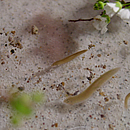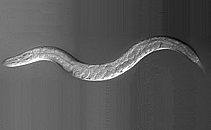| |
|
|
|
|
| |
|
|
 |
 |
|
| |
 |
Common name: Fission yeast
Scientific name: Schizosaccharomyces pombe
Yeasts are known for their use as fermenting agents in the production of wine and beer, but they are also found in life sciences laboratories around the world, performing a very different but equally valuable service. The fission yeast has served as an experimental model for the past fifty years, thanks to it amenability to molecular genetic studies and the ease which it can be grown and manipulated in culture, and it is perhaps best known for its contributions to our knowledge of the cell cycle. |
|
 |
|
 |
 |
 |
Common name: fruit fly
Scientific name: Drosophila melanogaster
The fruit fly came into its own as a laboratory model owing in part to that very fecundity. Scientists in the early twentieth century discovered Drosophila was easy to keep, feed and breed, and by the 1920s fruit flies were the subject of extensive experiments in heredity in the labs of Nobel Prize-winner T. H. Morgan and elsewhere. As its popularity as a model increased, data on all aspects of fly biology, from molecular genetics to learned behaviors, burgeoned. The discovery of homeotic genes in the fly, which determine segment identity and which were found to be conserved in animals from worms to humans, made Drosophila a favorite of developmental biologists as well. |
|
 |
|
 |
 |
 |
Common name: Planarian
Scientific name: Dugesia japonica
Found in freshwater streams and ponds, planarians are small worms only a few millimeters long which possess simple brains, nervous and digestive systems, and a strangely endearing pair of rudimentary eyes. Their most striking characteristic, however, is their regenerative ability; cut a single animal into dozens, even hundreds of pieces, and each fragment can develop into a new individual. This remarkable capacity has attracted the attention of biologists interested in the mechanisms of regeneration and much progress has been made in recent years in understanding how the planarian achieves its death-defying multiplication. The answer lies in the totipotent cells distributed throughout its tiny body, cells it is hoped will provide clues to the emerging field of regenerative medicine. |
 |
|
 |
 |
 |
Common name: nematode
Scientific name: Caenorhabditis elegans
With exactly 959 somatic cells in the body of a normal adult, the nematode offers perhaps the best-characterized model of a multicellular organism possessing simple nervous, muscle and reproductive systems. It is possible to track the fates of individual cells in its transparent body on a microscope slide glass, and the exact fate of every cell in every cell lineage is known. In 1998, geneticists added to that body of knowledge by sequencing the nematode genome, which was found to contain around 19,000 genes, many of which have human homologs. The discovery of the RNA interference mechanism that allows genes to be functionally 'knocked down' has only fueled interest in these tiny creatures as model organisms.
|
 |
|
 |
 |
 |
Common name: Zebrafish
Scientific name: Brachydanio rerio
The zebrafish, with its short reproductive cycle and high number of eggs per clutch, is one of the most popular vertebrate systems used in genetic analysis. Its rapid development has also made it popular in the developmental biology and embryology communities, as has the fact that its eggs are externally fertilized and translucent, making it possible to follow its developmental progress easily using a dissecting microscope. The tractability of this fish to gene knockout methods and the existence of techniques for producing large numbers of clones have also helped to establish it as a favorite system in developmental genetics. |
 |
|
 |
 |
 |
Common name: African clawed frog
Scientific name: Xenopus laevis
The African clawed frog has a long history of use in the study of vertebrate embryology and development. As aquatic animals, they undergo external development, making it relatively easy to manipulate the fertilized egg as compared to animals in which the embryo grows within the uterus. Their eggs are also quite large, about 1 mm in diameter, which about ten times the size of a mouse oocyte. Ovulation can be induced relatively simply using luteinizing hormone, which eliminates some of the problems associated with extended reproductive cycles. And their rapid progress from fertilization to neurulation in less than 24 hours provides scientists with a dynamic picture of the first stages of life. |
|
 |
|
 |
 |
 |
Common name: chick (chicken)
Scientific name: Gallus gallus
The chick embryo has been in use as a model since the time of Aristotle, making it one of the most exhaustively studied systems in biology. The egg's extrauterine development made it attractive in the days before surgical techniques. The chicken's regular laying cycle and the fact that fertilized eggs can be cold-stored for several weeks, temporarily freezing their development, ensures constant access to embryos. Chick embryonic development shows some similarity to that of mammals, and the flat blastodisc of the chick is morphologically similar to the human embryo at the same stage of development. The introduction of techniques for embryonic sectional explantation and the production of chick-quail chimeras has only served to add to the popularity of the chick embryo as a model system. |
 |
|
 |
 |
 |
Common name: mouse
Scientific name: Mus musculus
For nearly one hundred years the mouse has been the animal of choice for modeling human genetics and disease. This application has been borne out by the recent completed sequencing of the mouse genome, which revealed an extremely high homology between the mouse and human genomes. As fellow mammals, humans and mice also share many physiological traits and susceptibilities, making the mouse an attractive model in biomedical studies. Its rapid breeding cycle and small size further add to its appeal, and it is little wonder that scientists have chosen this animal for developing or popularizing a wide range of genetic techniques from transgenesis to gene knockouts to cloning by nuclear transfer. |
 |
|
 |
 |
| |
| |
|
| |
|
|
|